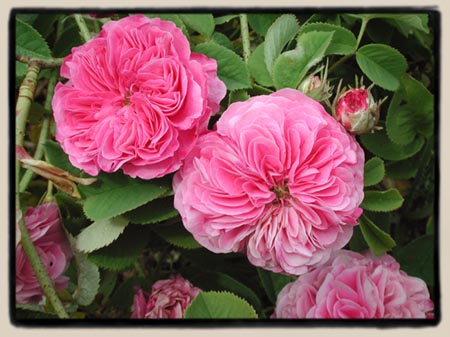 |
|
Albas |
'Desirée Parmentier', likely by Parmentier, Belgium. Dated pre-1848.
I think that this is a very sophisticated rose, and it survives zone5b cold winters without any damage. I have seen houses surrounded by hedges of 'Desirée Parmentier', and it is an extraordinary sight in full bloom. I have also seen it grown as a climber of sorts, and if trained properly, it can make a mass of growth up to 10 feet in height. As a shrub, it is very upright for a Gallica, tending to grow straight up to 6 feet, and a narrow 3 feet across, very similar to the Alba that bears its "sister" name, 'Felicité Parmentier'. It seems very likely that this is a hybrid including Centifolia genes in its background. Desirée's blooms are a very vibrant mid- pink that fades to pale around the edges, and they are very full, as the picture reveals. There are at least a hundred and fifty small petals filling this rounded bloom, and it produces a very fine, strong Damask/Gallica scent. The leaves are typical Gallica, but a bit more coarse than the average. It is very disease resistant, and survives with little attention. All of the plants I have seen are surviving under much less than optimum conditions, sometimes in fairly heavy shade too, and yet they bloom profusely. I think it is a shame that for some reason this rose is not very common in commerce, as it is a very beautiful thing, and should be grown more often. I am particularly fond of this rose, and recommend it highly. PS: There is some doubt as to the identity of this rose, and it is possible that this may in fact be 'Prolifera de Redoute'. ARS
merit rating:
7.0 Original photographs and site content © Paul Barden 2006, All Rights Reserved. |
|

 'Desirée
Parmentier' is the first gallica that I came to know as an unnamed
found rose. I grew it for almost two years before I came close to having
an official name for it. A woman living a few minutes walk from my house
had a very large plant of this rose growing in her front yard, and one
day I stopped when I saw her out in her yard tidying up. When I asked
her if she knew the name of her rose, I realised that she didn't speak
english at all well. (she was an older Chinese woman) She could only
answer, "Rose", and smile. I asked her if I might have a cutting or
two of her shrub, and she nodded yes and gestured to the bush. I started
to remove a couple of modest cuttings, and she proclaimed loudly, "no,
no!" and rushed back into her house. I thought perhaps she had not realised
what I had asked for, and had run to get help. Instead she came back
with large loppers in hand, and proceeded to chop off several large
branches of this rose for me! I had to stop her from cutting, as I had
much more than I could use. I had a bowl full of Desirée Parmentier
blooms in my kitchen for days, as well as all the cuttings I could possibly
root.
'Desirée
Parmentier' is the first gallica that I came to know as an unnamed
found rose. I grew it for almost two years before I came close to having
an official name for it. A woman living a few minutes walk from my house
had a very large plant of this rose growing in her front yard, and one
day I stopped when I saw her out in her yard tidying up. When I asked
her if she knew the name of her rose, I realised that she didn't speak
english at all well. (she was an older Chinese woman) She could only
answer, "Rose", and smile. I asked her if I might have a cutting or
two of her shrub, and she nodded yes and gestured to the bush. I started
to remove a couple of modest cuttings, and she proclaimed loudly, "no,
no!" and rushed back into her house. I thought perhaps she had not realised
what I had asked for, and had run to get help. Instead she came back
with large loppers in hand, and proceeded to chop off several large
branches of this rose for me! I had to stop her from cutting, as I had
much more than I could use. I had a bowl full of Desirée Parmentier
blooms in my kitchen for days, as well as all the cuttings I could possibly
root.